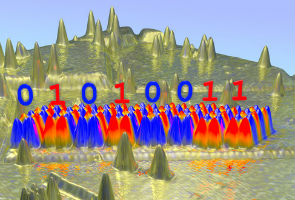- Home
- Others
- Others News
- New Storage Device Is Very Small, at 12 Atoms
New Storage Device Is Very Small, at 12 Atoms
By John Markoff, New York Times | Updated: 5 June 2012 01:19 IST

Click Here to Add Gadgets360 As A Trusted Source

Advertisement
Researchers at I.B.M. have stored and retrieved digital 1s and 0s from an array of just 12 atoms, pushing the boundaries of the magnetic storage of information to the edge of what is possible.
The findings, being reported Thursday in the journal Science, could help lead to a new class of nanomaterials for a generation of memory chips and disk drives that will not only have greater capabilities than the current silicon-based computers but will consume significantly less power. And they may offer a new direction for research in quantum computing.
"Magnetic materials are extremely useful and strategically important to many major economies, but there aren't that many of them," said Shan X. Wang, director of the Center for Magnetic Nanotechnology at Stanford University. "To make a brand new material is very intriguing and scientifically very important."
Until now, the most advanced magnetic storage systems have needed about one million atoms to store a digital 1 or 0. The new achievement is the product of a heated international race between elite physics laboratories to explore the properties of magnetic materials at a far smaller scale.
Last May, a group at the Institute of Applied Physics at the University of Hamburg in Germany reported on the ability to perform computer logic operations on an atomic level.
The group at I.B.M.'s Almaden Research Center here, led by Andreas Heinrich, has now created the smallest possible unit of magnetic storage by painstakingly arranging two rows of six iron atoms on a surface of copper nitride.
Such closeness is possible because the cluster of atoms is antiferromagnetic -- a rare quality in which each atom in the array has an opposed magnetic orientation. (In common ferromagnetic materials like iron, nickel and cobalt, the atoms are magnetically aligned.)
Under the laboratory's founder, Don Eigler, I.B.M. has explored the science of nanomaterials far smaller than the silicon chips used in today's semiconductors. Dr. Eigler recently retired from the company but is a co-author of the Science paper.
The researchers now use a scanning tunneling microscope, which looks like a giant washing machine festooned with aluminum foil, not only to capture images of atoms but to reposition individual atoms -- much the way a billiard ball might be moved by a pool cue with a sticky tip.
Although the research took place at a temperature near absolute zero, the scientists wrote that the same experiment could be done at room temperature with as few as 150 atoms.
As part of its demonstration of the antiferromagnetic storage effect, the researchers created a computer byte, or character, out of an individually placed array of 96 atoms. They then used the array to encode the I.B.M. motto "Think" by repeatedly programming the memory block to store representations of its five letters.
Moreover, Dr. Heinrich said, smaller groups of atoms begin to exhibit quantum mechanical behavior -- simultaneously existing in both "spin" states, in effect 1 and 0 at the same time.
In theory, such atoms could be assembled into Qbits -- the basic unit of an experimental approach to computing that might one day exceed the capabilities of today's most powerful supercomputers.
"If you do this with two atoms, then they behave more like a quantum mechanical object," Dr. Heinrich said. "This is why science is interested in this work more than the technology."
In an interview in a small laboratory office here, he said he was planning to knock out a wall to create room for an expanded effort in exploring the quantum mechanical properties of the antiferromagnetic effect.
"This is really where we live," he said. "If you step outside of the press release, we are trying to control the quantum mechanics of this spin behavior to coax them to do whatever we want them to do."
Computer industry analysts said the I.B.M. effort heralded a new direction for nanotechnology and that it might offer a route to new kinds of nanomaterials.
"Nanotechnology labs are going to begin asking, 'What else is going on down there?' " said Richard Doherty an electrophysicist who is director of Envisioneering, an industry consulting firm based in Seaford, N.Y. "The information storage side of this is fantastic, but this truly changes our ideas of the behavior of materials at molecular levels."
Antiferromagnetic materials are now instrumental in two types of data storage products. They are essential for the manufacture of recording heads, which resemble phonograph needles and are used in today's hard disk drives. They are also used in a new type of memory chip known as spin-transfer-torque RAM, or STT-RAM, which some view as a future competitor for DRAM and Flash memory chips.
Dr. Heinrich said that the tiny devices built with scanning tunneling microscopes would never be more than laboratory experiments.
However, he noted that many research groups are exploring ways of designing novel materials using self-assembly methods, including mechanical and biological approaches.
Industry executives said that as the semiconductor industry draws closer to exhausting the ability to scale down today's circuits using lithographic tools that etch patterns on the surface of silicon wafers, an intense international hunt is under way for a manufacturing technology beyond microelectronics.
"The nation that discovers the next logic switch will lead the nanoelectronics era and reap the economic rewards associated with it," said Ian Steff, vice president for global policy and technology partnerships of the Semiconductor Industry Association.
The findings, being reported Thursday in the journal Science, could help lead to a new class of nanomaterials for a generation of memory chips and disk drives that will not only have greater capabilities than the current silicon-based computers but will consume significantly less power. And they may offer a new direction for research in quantum computing.
"Magnetic materials are extremely useful and strategically important to many major economies, but there aren't that many of them," said Shan X. Wang, director of the Center for Magnetic Nanotechnology at Stanford University. "To make a brand new material is very intriguing and scientifically very important."
Until now, the most advanced magnetic storage systems have needed about one million atoms to store a digital 1 or 0. The new achievement is the product of a heated international race between elite physics laboratories to explore the properties of magnetic materials at a far smaller scale.
Last May, a group at the Institute of Applied Physics at the University of Hamburg in Germany reported on the ability to perform computer logic operations on an atomic level.
The group at I.B.M.'s Almaden Research Center here, led by Andreas Heinrich, has now created the smallest possible unit of magnetic storage by painstakingly arranging two rows of six iron atoms on a surface of copper nitride.
Such closeness is possible because the cluster of atoms is antiferromagnetic -- a rare quality in which each atom in the array has an opposed magnetic orientation. (In common ferromagnetic materials like iron, nickel and cobalt, the atoms are magnetically aligned.)
Under the laboratory's founder, Don Eigler, I.B.M. has explored the science of nanomaterials far smaller than the silicon chips used in today's semiconductors. Dr. Eigler recently retired from the company but is a co-author of the Science paper.
The researchers now use a scanning tunneling microscope, which looks like a giant washing machine festooned with aluminum foil, not only to capture images of atoms but to reposition individual atoms -- much the way a billiard ball might be moved by a pool cue with a sticky tip.
Although the research took place at a temperature near absolute zero, the scientists wrote that the same experiment could be done at room temperature with as few as 150 atoms.
As part of its demonstration of the antiferromagnetic storage effect, the researchers created a computer byte, or character, out of an individually placed array of 96 atoms. They then used the array to encode the I.B.M. motto "Think" by repeatedly programming the memory block to store representations of its five letters.
Moreover, Dr. Heinrich said, smaller groups of atoms begin to exhibit quantum mechanical behavior -- simultaneously existing in both "spin" states, in effect 1 and 0 at the same time.
In theory, such atoms could be assembled into Qbits -- the basic unit of an experimental approach to computing that might one day exceed the capabilities of today's most powerful supercomputers.
"If you do this with two atoms, then they behave more like a quantum mechanical object," Dr. Heinrich said. "This is why science is interested in this work more than the technology."
In an interview in a small laboratory office here, he said he was planning to knock out a wall to create room for an expanded effort in exploring the quantum mechanical properties of the antiferromagnetic effect.
"This is really where we live," he said. "If you step outside of the press release, we are trying to control the quantum mechanics of this spin behavior to coax them to do whatever we want them to do."
Computer industry analysts said the I.B.M. effort heralded a new direction for nanotechnology and that it might offer a route to new kinds of nanomaterials.
"Nanotechnology labs are going to begin asking, 'What else is going on down there?' " said Richard Doherty an electrophysicist who is director of Envisioneering, an industry consulting firm based in Seaford, N.Y. "The information storage side of this is fantastic, but this truly changes our ideas of the behavior of materials at molecular levels."
Antiferromagnetic materials are now instrumental in two types of data storage products. They are essential for the manufacture of recording heads, which resemble phonograph needles and are used in today's hard disk drives. They are also used in a new type of memory chip known as spin-transfer-torque RAM, or STT-RAM, which some view as a future competitor for DRAM and Flash memory chips.
Dr. Heinrich said that the tiny devices built with scanning tunneling microscopes would never be more than laboratory experiments.
However, he noted that many research groups are exploring ways of designing novel materials using self-assembly methods, including mechanical and biological approaches.
Industry executives said that as the semiconductor industry draws closer to exhausting the ability to scale down today's circuits using lithographic tools that etch patterns on the surface of silicon wafers, an intense international hunt is under way for a manufacturing technology beyond microelectronics.
"The nation that discovers the next logic switch will lead the nanoelectronics era and reap the economic rewards associated with it," said Ian Steff, vice president for global policy and technology partnerships of the Semiconductor Industry Association.
Comments
Get your daily dose of tech news, reviews, and insights, in under 80 characters on Gadgets 360 Turbo. Connect with fellow tech lovers on our Forum. Follow us on X, Facebook, WhatsApp, Threads and Google News for instant updates. Catch all the action on our YouTube channel.
Further reading:
nanotechnology, small gadgets
Related Stories
Popular on Gadgets
- Samsung Galaxy Unpacked 2025
- ChatGPT
- Redmi Note 14 Pro+
- iPhone 16
- Apple Vision Pro
- Oneplus 12
- OnePlus Nord CE 3 Lite 5G
- iPhone 13
- Xiaomi 14 Pro
- Oppo Find N3
- Tecno Spark Go (2023)
- Realme V30
- Best Phones Under 25000
- Samsung Galaxy S24 Series
- Cryptocurrency
- iQoo 12
- Samsung Galaxy S24 Ultra
- Giottus
- Samsung Galaxy Z Flip 5
- Apple 'Scary Fast'
- Housefull 5
- GoPro Hero 12 Black Review
- Invincible Season 2
- JioGlass
- HD Ready TV
- Laptop Under 50000
- Smartwatch Under 10000
- Latest Mobile Phones
- Compare Phones
Latest Gadgets
- OnePlus 15R
- Realme Narzo 90x 5G
- Realme Narzo 90 5G
- Vivo S50 Pro Mini
- Vivo S50
- OPPO Reno 15c
- Redmi Note 15 5G
- Redmi Note 15 Pro 5G
- Asus ProArt P16
- MacBook Pro 14-inch (M5, 2025)
- Infinix Xpad Edge
- OnePlus Pad Go 2
- OnePlus Watch Lite
- Just Corseca Skywatch Pro
- Acerpure Nitro Z Series 100-inch QLED TV
- Samsung 43 Inch LED Ultra HD (4K) Smart TV (UA43UE81AFULXL)
- Asus ROG Ally
- Nintendo Switch Lite
- Haier 1.6 Ton 5 Star Inverter Split AC (HSU19G-MZAID5BN-INV)
- Haier 1.6 Ton 5 Star Inverter Split AC (HSU19G-MZAIM5BN-INV)
© Copyright Red Pixels Ventures Limited 2025. All rights reserved.

















